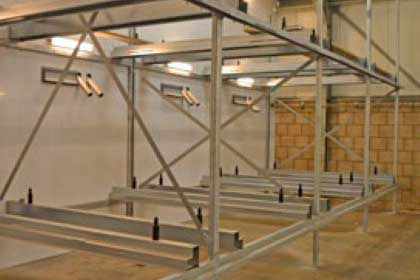Schippers launches mobile farrowing and weaning pens

Dutch livestock equipment company MS Schippers has launched a system using mobile farrow-to-weaning pens.
The so-called ‘Hy-Care’ system is aimed at high hygiene situation in the farrowing and early weaning phase was launched at the company’s first ‘Global Event’ at the headquarters in Bladel, the Netherlands.
Key in the system is to treat piglets on a central spot. After use, the pens can be cleaned in a washing machine in a fully automated process. The aim is to reduce both piglet mortality as well as antibiotics use in the first weeks of life until the pigs reach approximately 25kg.
The easy-to-clean plastic mobile pens are 2.60 m long and 1.90 m wide. The system was designed by a team which included director Mark Schippers and Mart Smolders.
Automated
The pens can be used for farrowing, farrow-to-weaning or weanling pens. The pens can be moved by a completely automated transport system. Treatments like earmarks, iron injections etc., can all occur in a special room. Once per week the pigs’ manure will be trucked from the pens to a special storage facility.
The mobile pens can be built in layers. Cameras will control the system – and the pig house will be constructed in such a way that all technical, feeding and ventilation equipment is situated in a purpose-built technique corridor. This way, cleaning is easy and less problems will occur as a result of moist in the feed or climate installations.
Research to the system is being done in cooperation with the Swine Innovation Centre in Sterksel as well as with Wageningen University.
Reactions
First reactions varied from positive to critical. Advantages of the system include a draught-free pen with round edges, which avoids piglet hypothermia as they cannot get out of their corners.
In addition, the piglet pens have a high hygiene level, reducing the chances for infections.
Another advantage is that labour requirements are less. As pens are mobile, there is no need for a lot of walking.
Aspects
Annechien ten Have, ex-chairwoman of the Dutch Agricultural & Horticultural Organisation (LTO), commented: “Several aspects offer possibilities. We will have to be careful though to consider pigs as ‘things’. But I can very well imagine how piglets get delivered. All you need to do is move the pens – not the animals.”
Stefan Derks, manager at Klasse-KI, is less positive for the Dutch market. “It will not go down well with the general public. It will be perceived as too industrial.” Markets like Russia, China and the Americas may offer more opportinities, he added.
Pig trader Kees Oostrom pointed to improvements – and stated that the pens could also be closed on the top. This way a fully climatised pen could be constructed, avoiding air infections to occur.











